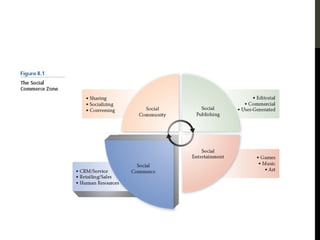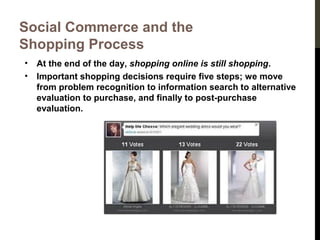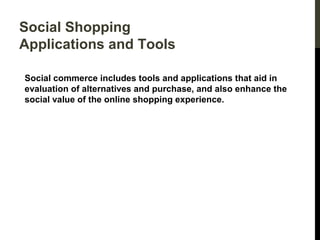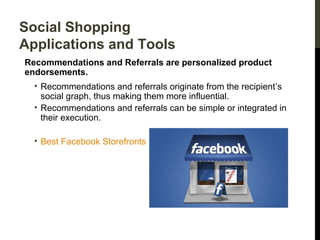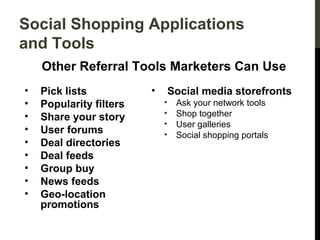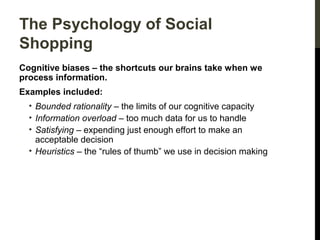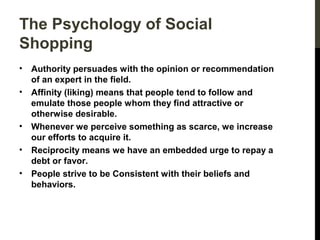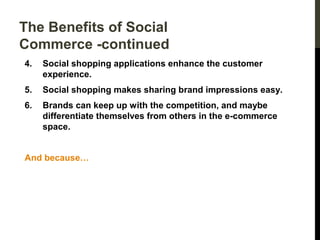MKT 380 Week 9
- 1. MKT 380 Week 9 Intr oduction to Social Media Mar keting
- 2. Chapter Objectives • • • • Describe the relationship between social commerce and ecommerce Discuss the value of ratings and reviews to both online consumers and e-retailers Explain how social shopping applications and tools affect the consumer decision-making process Describe the psychological factors that influence social shopping
- 3. The Zone of Social Commerce Social commerce is a subset of e-commerce (i.e., the practice of buying and selling products and services via the Internet). Social shopping refers to situations where consumers interact with others during a shopping event.
- 5. Social Commerce: The Digital Shopping Experience A shopper’s motivation influences the type of shopping environment that will be attractive or annoying Hedonic shopping motives include social experiences, opportunities to share common interests with like-minded others, the sense of importance we experience when others wait on us, and the thrill of the hunt. Social Shopping
- 6. Social Commerce and the Shopping Process • • At the end of the day, shopping online is still shopping. Important shopping decisions require five steps; we move from problem recognition to information search to alternative evaluation to purchase, and finally to post-purchase evaluation.
- 8. Ratings and Reviews Ratings are scores that people, acting in the role of critics, assign to something as an indicator. Reviews are assessments with detailed comments about the object in question. Click here to see the power of ratings and
- 9. Ratings and Reviews The Value of a Review • Ratings and reviews are not always useful. • Ratings are a heuristic; a mental shortcut consumers use to help them with decision making. • Reviews provide more detailed information for those who want to evaluate the choice at a deeper level.
- 10. Ratings and Reviews Benefits to E-retailers • Online reviews generate increased sales by bringing in new customers. • People who write reviews tend to shop more frequently and spend more online than others.
- 11. Ratings and Reviews So, what does this all mean for marketers? 1.Marketers must ensure high standards when it come to product quality and service. 2.Brands should embrace consumer options and not try to hide from them. 3.Organizations should engage in word-of-mouth marketing by actively giving people reasons to talk about the brand.
- 12. Ratings and Reviews Why Don’t All E-retailers Offer Reviews and Ratings on Their Sites? Fear that dissatisfied customers will use the review feature as a venue to flame a brand is the most commonly cited reason.
- 13. Ratings and Reviews Best Practices to Leverage Social Reviews and Ratings • Authenticity: Accept organic word of mouth. • Transparency: Acknowledge opinions that were invited, incentivized, or facilitated by the brand, • Advocacy: Enable consumers to rate the value of opinions offered on the site. • P articipatory: Encourage consumers to contribute posts. • Reciprocity: Acknowledge the value of the opinions customers offer. • Infectiousness: Make it easy for users to share reviews on blogs and social networking platforms. • Sustainability: Online opinions are influential because they live on in perpetuity.
- 14. Social Shopping Applications and Tools Social commerce includes tools and applications that aid in evaluation of alternatives and purchase, and also enhance the social value of the online shopping experience.
- 15. Social Shopping Applications and Tools Recommendations and Referrals are personalized product endorsements. • Recommendations and referrals originate from the recipient’s social graph, thus making them more influential. • Recommendations and referrals can be simple or integrated in their execution. • Best Facebook Storefronts
- 16. Social Shopping Applications and Tools Other Referral Tools Marketers Can Use • • • • • • • • • Pick lists Popularity filters Share your story User forums Deal directories Deal feeds Group buy News feeds Geo-location promotions • Social media storefronts • • • • Ask your network tools Shop together User galleries Social shopping portals
- 18. The Psychology of Social Shopping Cognitive biases – the shortcuts our brains take when we process information. Examples included: • Bounded rationality – the limits of our cognitive capacity • Information overload – too much data for us to handle • Satisfying – expending just enough effort to make an acceptable decision • Heuristics – the “rules of thumb” we use in decision making
- 19. The Psychology of Social Shopping Social Proof is the belief that when a lot of people select one option, then it must be the right option. • Herding behavior occurs when people follow the behavior of others • Conformity is a change in beliefs or actions as a reaction to group pressure (real or imagined)
- 20. The Psychology of Social Shopping We don’t mimic others’ behaviors all the time, so what makes it more likely we will conform? • Cultural pressures • Fear of deviance • Commitment • Group unanimity, size and expertise • Susceptibility to interpersonal influence
- 21. The Psychology of Social Shopping • • • • • Authority persuades with the opinion or recommendation of an expert in the field. Affinity (liking) means that people tend to follow and emulate those people whom they find attractive or otherwise desirable. Whenever we perceive something as scarce, we increase our efforts to acquire it. Reciprocity means we have an embedded urge to repay a debt or favor. People strive to be Consistent with their beliefs and behaviors.
- 22. The Benefits of Social Commerce 1. 2. 3. It enables the marketer to monetize the social media investment by boosting site and store traffic, converting browsers to buyers, and increasing average order value. It solves the dilemma of social media ROI. Social commerce applications results in more data about customer behavior as it relates to the brand. continued
- 23. The Benefits of Social Commerce -continued 4. Social shopping applications enhance the customer experience. 5. Social shopping makes sharing brand impressions easy. 6. Brands can keep up with the competition, and maybe differentiate themselves from others in the e-commerce space. And because…
Editor's Notes
- Of course, just as in the physical world this changes the dynamic of shopping because it opens the door for others to influence our decisions.
- It’s a cold day in mid-December, and David is spending some time on Facebook reading about his friends’ recent activities. A social ad for 1-800-Flowers appears on the side of his news feed that promotes flowers as a Christmas gift and provides an endorsement that thousands of people like 1-800-Flowers. Remembering that he hasn’t yet sent a Christmas gift to his grandmother in Texas, David gets a brainstorm—he really doesn’t have the time to spend hours at the mall looking for something for Grammy. He clicks the ad to reach 1-800-Flowers’ Facebook page. There he sees a promotion for 20% off his order if he “likes” the page and a “Shop Now” call to action. With a click of the Shop Now button or the Shop tab on 1-800-Flowers’ page, David can browse flower selections and price points. Not sure whether 1-800-Flowers is the best choice, David first visits 1-800-Flowers’ Wall. Comments from past customers fill the page and David can read the posts from satisfied and unsatisfied customers along with the responses from company service representatives. He chooses three arrangements he likes, but then he posts a message to this two sisters to help him decide which is best. They both respond within 10 minutes (and as usual, they both pick the same one!). David now is confident he’s got a winner, so he returns to the Shop tab where he chooses the arrangement and completes his transaction using Facebook Credits. Share technologies are used to post to David’s Wall—“David bought a holiday arrangement at 1-800-Flowers” and “David likes 1-800-Flowers.” Once the flowers arrive, David plans to return to the page to share a review on 1-800-Flowers’ Wall. From there, the cycle begins again as another individual sees shared posts about the brand and/or social ads. Figure 8.2 illustrates how David’s actions map to the consumer decision-making process—and he went through the whole process without leaving Facebook.
- When we look at these stages we realize that what seems at first to be an “obvious” and quick decision (“throw something in the cart”) is in fact a lot more complicated. On the bright side, many current social media applications are out there to help consumers make it through each of these stages.
- The publication of consumer opinions is a powerful and influential form of user-generated content. In fact, one could claim online word-of-mouth communication of product reviews and opinions is the most influential form of user-generated content. Consumer opinions arise as typical people are empowered to express themselves and share these expressions with others, and as typical consumers seek out unbiased, credible information to aid in decision making. Not all ratings and reviews are user-generated. Some sites provide ratings and reviews from experts. For instance, the popular movie review site Rotten Tomatoes summarizes professional reviews of newly released movies and DVDs. However, what really matters when it comes to ratings and reviews is the opinion of other shoppers. Arnold Brown, a writer for The Futurist, captured the phenomenon, calling it “zagating the marketplace.” Just as the Zagat guide to hotels and restaurants polls actual diners and hotel patrons to create its ratings and reviews, online reviews and ratings provide a venue for people who are experts by virtue of their experience to share their opinions. The estimated usage of ratings and reviews among online consumers during the buying process varies substantially from source to source, ranging from 42 to more than 70%. Of the sources of social media that might influence buyer behavior, ratings and reviews were used more than any other source. Consumers say they trust information provided online by other consumers more than television, magazine, radio, or Internet advertising, more than sponsorships, and more than recommendations from salespeople or paid endorsers.
- Those who review products make up just a quarter of online shoppers, but they account for a third of online sales. Consumers are willing to pay a price premium for products with higher ratings.
- The Word of Mouth Marketing Association (WOMMA) identifies five key components to word-of-mouth marketing, all of which can be applied to managing online product opinions for brand value: • Educating people about your products and services; • Identifying people most likely to share their opinions; • Providing tools that make it easier to share information; • Studying how, where, and when opinions are being shared; and • Listening and responding to supporters, detractors, and neutrals.
- Given the old adage that negative word-of-mouth communication is more damaging than positive word-of-mouth communication is beneficial, some retailers have erred on the side of caution when it comes to offering a review feature. In reality, retailers can benefit from negative reviews and should welcome them. Consumers want to see negative reviews to be able to accurately assess the degree of product risk they face when purchasing. They seek to minimize perceived performance and financial risk associated with purchases. Negative reviews give them the information they need to assess risk. The negative reviews also enhance credibility. Consumers often assume that if the reviews seem too good to be true, they probably are. Lastly, negative reviews give valuable information to the retailer on products that should be improved, augmented, or discontinued.
- Google has successfully used referral programs to encourage usage of its products. As it introduces a new service in beta, Google will issue a limited number of invitations. Those new users are then allowed a limited number of invitations they may share with others. The use of a referral program enhances the perceived value of the product while it also builds adoption through a credible network. Pick lists: item lists such as wish lists and gift lists; pick lists usually also offer a sharing feature Popularity filters: filters that enable the shopper to show products by most popular, most viewed, most favorite, or most commented Share Your Story: tools for publishing customer testimonials; includes video testimonials and narratives submitted by customers Recommendations: personal shopping suggestions made by friends or the site (based on similarities) User forums: group of people who meet online to communicate about products and help each other solve related problems Deal directories: collections of special offers; sometimes maintained and updated by user submissions Deal feeds: a stream of offers made by participating businesses to followers/friends Group buy: opportunities for people to join together to qualify for volume discounts; some communities have developed around the concept of group buy such as Groupon or LivingSocial News feeds: syndicated news distributed via social media channels or RSS to provide a resource for exclusive information and (often) special deals Geo-location promotions: sales promotions including coupons and special offers delivered via geo-location services such as Gowalla and Foursquare Social media storefronts: applications that enable businesses to conduct transactions with customers from within social network sites Share and ask your network tools: share and query tools within e-commerce sites that enable one to post product information and ask friends for advice prior to purchase Shop together: an application that allows shoppers to log in to an e-commerce site and then interact and collaborate throughout the e-commerce site; includes the ability to see purchase pals’ movement throughout the site, discussion, and sharing Social games and branded entertainment: advergames and branded applications that use entertainment as a tool for building loyalty and commitment to a brand while encouraging shoppers to spend time with the brand User galleries: a virtual gallery where users can share their creations, shopping lists, and wishlists; these exist outside of social commerce but may include galleries that feature products for sale Social bookmarking for products: shopping-oriented bookmarking sites like Snipi enable online shoppers to bookmark products they like and share the lists with others Social shopping portals: sites that enable shoppers to shop multiple stores (like a mall) using several social shopping tools
- • Cultural pressures: Different cultures encourage conformity to a greater or lesser degree. The American slogan “Do your own thing” in the 1960s reflected a movement away from conformity and toward individualism. In contrast, Japanese society emphasizes collective well-being and group loyalty over individuals’ needs. • Fear of deviance: The individual may have reason to believe that the group will apply sanctions to punish nonconforming behaviors. It’s not unusual to observe adolescents who shun a peer who or he is not a “team player.” • Commitment: The more people are dedicated to a group and value their membership in it, the greater their motivation to conform to the group’s wishes • Group unanimity, size, and expertise: As groups gain in power, compliance increases. It is often harder to resist the demands of a large number of people than only a few—especially when a “mob mentality” rules. • Susceptibility to interpersonal influence: This trait refers to an individual’s need to have others think highly of him or her.
- Whenever someone has expertise, whether that expertise comes from specialist knowledge and/or personal experience with the product or problem, we will tend to follow that person’s advice. We can save time and energy on the decision by simply following the expert’s recommendation. When we fail to behave in ways that are consistent with our attitudes and past behaviors, we feel cognitive dissonance, a state of psychological discomfort caused when things we know or do contradict one another.



